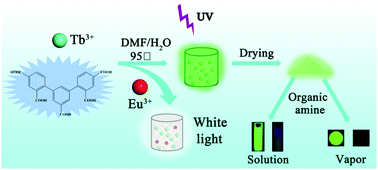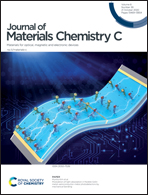Water-stable lanthanide-based metal–organic gel for the detection of organic amines and white-light emission†
Abstract
Highly luminous lanthanide metal–organic gels (Ln-MOGs) can act as fluorescent probes for the detection of organic amines and can also be used to build white-light emitting materials based on the different luminescent properties of lanthanide ions. Here, we reported a Ln-MOG constructed with a 3,5-di(2′,4′-dicarboxylphenyl)benozoic acid (DPBA) ligand and Tb3+. Tb-MOG has an excellent fluorescence detection effect on organic amines including ethylenediamine, triethylamine, diisopropylamine and aniline in aqueous solution, and their detection limits reach a sub-ppm level. Considering the practicality, a Tb-MOG testing paper was prepared by a spin coating process, which can detect volatile organic amine vapors with good recyclability. Additionally, a single-phase white-light Tb0.84Eu0.16-MOG material was realized by in situ doping of Tb-MOG with Eu3+ and reasonably utilizing the blue emission of DPBA.



 Please wait while we load your content...
Please wait while we load your content...